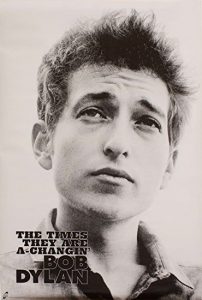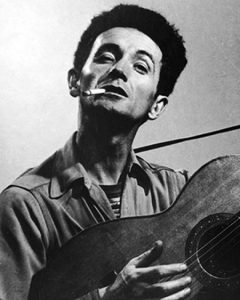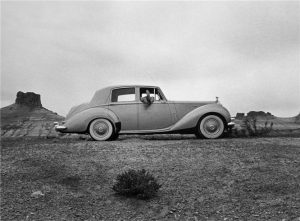By Patrick Roefflaer
- Released January 13, 1964
- Photograher Barry Feinstein
- Liner Notes Bob Dylan
- Art-director John Berg
On the cover of the 1970 album Delaney & Bonnie on Tour with Eric Clapton, there is a photo of a Rolls Royce. On the car’s front seat, someone seems to be asleep, as a pair of boots is sticking out of the open window.
The photographer was Barry Feinstein. These boots (and the feet in them) belong to Bob Dylan and the car was from his manager Albert Grossman.
It is that car that brought the singer and the photographer together.
In the early Sixties, Feinstein worked as freelance photographer for Life magazine. His work stands out, because of his unusual images of celebrities: from Hollywood stars to President John F. Kennedy. “I didn’t want to photograph the glamour end of it,” he later explained. “I wanted my pictures to say something. I don’t really like stand-up portraits, there’s nothing there, no life, no feeling. I was much more interested in capturing real moments. [….] It was the behind the scene thing – that part of Hollywood that nobody thinks about or looks at.”
In early September 1963, Feinstein was visiting the Grossman’s office in New York, when Bob Dylan walked in to see his manager.
Feinstein was a friend of Albert Grossman, whom he had met through his fiancée: Mary Travers – the singer of Peter, Paul and Mary, also clients of Grossman. The folk trio recently had a big hit with Dylan’s “Blowin” In The Wind”. Allegedly, Grossman bought the Rolls Royce with the money he made from that hit.
The vintage 1953 Silver Dawn is refurbished in a garage in Denver and now Grossman is looking for a volunteer to pick up the car and bring it home. Feinstein offers himself as a volunteer, but mentions that doesn’t like to make the trip alone. “Maybe Bob would like to take a ride with you,” suggests Grossman. Dylan is willing to come.
 Together they fly to Denver and then drive the 1.800 miles back. ‘It was a long drive but a fun trip,” Feinstein writes in his book Real Moments: Photographs of Bob Dylan 1966-1974.
Together they fly to Denver and then drive the 1.800 miles back. ‘It was a long drive but a fun trip,” Feinstein writes in his book Real Moments: Photographs of Bob Dylan 1966-1974.
“We stopped off along the way whenever we felt like it. Bob wanted to check out an old-style saloon bar in Central City, where he used to play the piano for a stripper.
“Each time we stopped more people would recognise Bob; he was really amused by it all. One time we pulled over to listen when a song from Bob’s new album played on the radio.
“We didn’t talk much unless there was something really to say. That’s how I am and it’s how Bob was too, so we got along fine. Over time we hung out more and understood each other’.”
En route, the two men become friends. So when a portrait for the sleeve of Dylan’s third album is needed, Feinstein is the obvious choice.
“Columbia asked me to do an album cover,” Feinstein explained. “So I took Bob up to my friend John Cort’s penthouse apartment in New York City. I said, ‘Let’s go to the edge on the balcony and make some pictures.’ I was kneeling down and I said to Bob, ‘Look around, look at the landscape, the city and this and that.’ I went click, click, click.
I didn’t have to shoot a lot of pict ures because I knew immediately it was a very unusual shot and an angle and a moment with Bob.” Ten minutes and the job is done.
ures because I knew immediately it was a very unusual shot and an angle and a moment with Bob.” Ten minutes and the job is done.
“We looked at the proof sheet and he chose that shot. In those days the record company normally chose the picture for the cover, especially Columbia, but they let him do it this time. They did a good job. It wasn’t premeditated or anything, it was one of the quickest and easiest photo sessions I’ve ever done.”
The Times They Are A-Changin ’is all about protest and social conflicts and the intense black-and-white photo portrait of a serious-looking Dylan emphasizes this.
He looks bleak, as if at the age of 22 he already has a cross to bear, the heavy burden of violence and the injustice of the world.
The resemblance to a portrait of Woody Guthrie is striking.
 Commissioned by Life, Feinstein follows Dylan’s tour of 1966 (think of the photo on the cover of No Direction Home) and is also the official tour photographer in 1974.
Commissioned by Life, Feinstein follows Dylan’s tour of 1966 (think of the photo on the cover of No Direction Home) and is also the official tour photographer in 1974.
Because of this and his cover photos for George Harrison (All Things Must Pass – 1970) and Janis Joplin (Pearl – 1971), Feinstein became an influential rock photographer.
This time a poem by Dylan appears on the back of the cover: “11 Outlined Epitaphs” The text continues on both sides of the inner cover.
In France, the album was renamed: ‘Mister’ Bob Dylan.
You might also enjoy
The untold story of the artwork on Bob Dylan’s Greatest Hits
The Sleeve Art of Bob Dylan’s album: “Bob Dylan”
The Freewheelin’ Bob Dylan – the untold story of the artwork of the album
The Sleeve Art of Bob Dylan’s Album: Slow Train Coming
What else is here?
An index to our latest posts arranged by themes and subjects on the home page. You can also see details of our main sections on this site at the top of this page under the picture.
There is an alphabetic index to the 550+ Dylan compositions reviewed on the site which you will find it here. There are also 500+ other articles on different issues relating to Dylan. The other subject areas are also shown at the top under the picture.
We also have a discussion group “Untold Dylan” on Facebook which mostly relates to Bob Dylan today. Just type the phrase “Untold Dylan” in, on your Facebook page or follow this link
And please do note The Bob Dylan Project, which lists every Dylan song in alphabetical order, and has links to licensed recordings and performances by Dylan and by other artists, is starting to link back to our reviews.



One of the Greatest Albums E V E R Recorded.